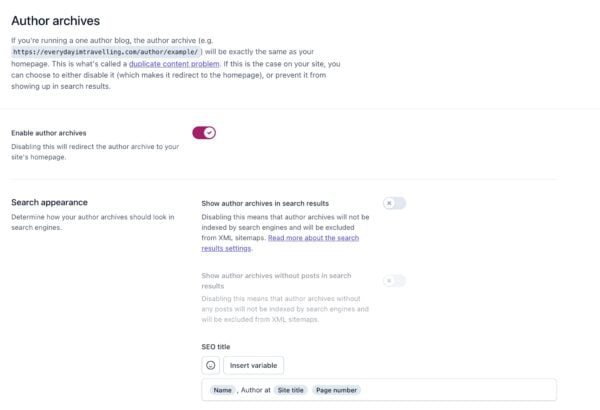If you use categories and tags, you will automatically create archive pages. These pages contain a list of the posts and pages within a specific category or tag. Besides categories and tags, there are date-based archive pages and author archives. These archive pages need managing because they cause SEO problems if you don’t.
First, you want to prevent search engines from indexing archive pages that don’t make sense on your site. You can use the Yoast SEO plugin for this. You do this under Yoast SEO → Advanced, where you’ll find the following options on the “Author Archives” tab:

On our site, we’ve disabled the date-based archives, as we don’t use
those. Any date-based link will redirect to our homepage because of this
setting. We’ve left the author archives untouched, but we have set the
subpages of those archives to be noindex, follow by default. This way, you’ll never land on page two of an archive on our site from the search engines.
If your blog is a one-author blog, or you don’t need author archives,
use Yoast SEO to disable the author archives. Also, if you don’t think
you need a date-based archive: disable it as we have. Even if you’re not
using these archives in your template, someone might link to them and
thus break your WordPress SEO…
There is one type of archive that is noindex,follow by default in the Yoast SEO plugin: your own internal search function result pages. This is a best practice from Google.
3.4.1. Pagination
If you have many posts on your WordPress site, you might want to think about how your pagination looks and works. Otherwise, your best content is ‘buried’ deep in your site, and users and search engines may struggle to find it. It would help if you also considered customizing how your pagination looks and works to be more helpful for users and search engines.
3.5. Configure your breadcrumbs
You’ll probably want to add breadcrumbs to your posts and pages. Breadcrumbs are the links, usually above the title post, that look like “Home > SEO blog > WordPress SEO“. Breadcrumbs are good for two things:
- They allow your users to navigate your site easily.
- They allow search engines to determine the structure of your site more easily.
These breadcrumbs should link back to the homepage and the post’s category. If the post is in multiple categories, it should pick one.
To get breadcrumb navigation to show you on your pages, you may need to adapt your single.php and page.php files in your theme and include the code for breadcrumbs from the Yoast SEO plugin. You find the settings and instructions on doing that in the Yoast SEO → Advanced → Breadcrumbs section. Also, we have a unique breadcrumbs block for the block editor that makes it easy to drop in breadcrumbs on any page — without writing code.


No comments:
Post a Comment